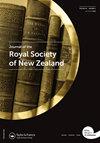Stem albatrosses wandered far: a new species of Plotornis (Aves, Pan-Diomedeidae) from the earliest Miocene of New Zealand
IF 2.1
4区 综合性期刊
Q2 MULTIDISCIPLINARY SCIENCES
引用次数: 0
Abstract
Albatrosses are among the most intensely studied groups of living birds, yet their fossil record remains sparse. Despite modern albatrosses being more abundant and widespread in the Southern Hemisphere, the vast majority of fossil albatrosses identified to date come from Northern Hemisphere localities. Here, we describe Plotornis archaeonautes sp. nov., a new albatross species from the earliest Miocene that represents the earliest record of Procellariiformes in New Zealand and the earliest uncontroversial record of the clade Pan-Diomedeidae from the Southern Hemisphere. Phylogenetic analyses support the placement of Plotornis outside of the clade uniting all extant albatrosses. The new fossil reveals that stem lineage albatrosses were widespread by the onset of the Neogene. Although the humerus of Plotornis archaeonautes exhibits a short processus supracondylaris dorsalis, this early species may have possessed at least one of the unique ossifications associated with the patagial bracing system present in modern albatrosses.干信天翁远走高飞:来自新西兰中新世早期的一种新种Plotornis(鸟类,泛双翅鸟科)
信天翁是被研究得最多的现存鸟类之一,但它们的化石记录仍然很少。尽管现代信天翁在南半球更为丰富和广泛,但迄今为止发现的绝大多数信天翁化石来自北半球的地区。在这里,我们描述了Plotornis archaeonautes sp. nov.,这是一种新的信天翁物种,来自最早的中新世,代表了新西兰最早的Procellariiformes记录,以及南半球最早的无争议的泛diomedeidae进化支记录。系统发育分析支持将Plotornis置于所有现存信天翁的分支之外。新的化石表明,茎系信天翁在新近纪开始时已经广泛分布。尽管古Plotornis archaeonautes的肱骨显示出一个较短的背髁上突,但这个早期物种可能至少拥有一种与现代信天翁的翼状支撑系统相关的独特骨化。
本文章由计算机程序翻译,如有差异,请以英文原文为准。
求助全文
约1分钟内获得全文
求助全文
来源期刊

Journal of the Royal Society of New Zealand
综合性期刊-综合性期刊
CiteScore
4.60
自引率
0.00%
发文量
74
审稿时长
3 months
期刊介绍:
Aims: The Journal of the Royal Society of New Zealand reflects the role of Royal Society Te Aparangi in fostering research and debate across natural sciences, social sciences, and the humanities in New Zealand/Aotearoa and the surrounding Pacific. Research published in Journal of the Royal Society of New Zealand advances scientific knowledge, informs government policy, public awareness and broader society, and is read by researchers worldwide.
 求助内容:
求助内容: 应助结果提醒方式:
应助结果提醒方式:


